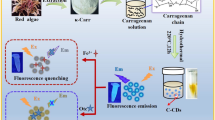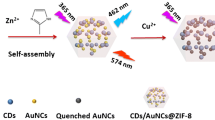Abstract
A lanthanide-free fluorescent probe has been constructed for the first time based on two-dimensional metal-organic frameworks (2D MOFs) and carbon dots (CDs) for ratiometric determination of dipicolinic acid (DPA), the biomarker of Bacillus anthracis. The fluorescence intensity at 659 nm increased due to the release of organic ligands TCPP resulting from the selective interaction between DPA and Zn2+ of 2D MOFs. CDs provided a reference signal at 445 nm which was almost unaffected, realizing self-calibration DPA sensing. F659/F445 versus the concentration of DPA shows good linear relationships in the range 0.01–0.2 μM and 0.2–10 μM under 390-nm excitation, with a detection limit of 7 nM. The ratiometric probe was prepared from 2D lanthanide-free MOFs so that the drawbacks of lanthanide-based probes were overcome. The proposed sensing system was successfully applied to the determination of DPA in spiked biological samples. These results suggest that a novel, simple, and selective strategy of determining DPA with 2D lanthanide-free MOFs is implemented.

Zn-TCPP nanosheets and a blue carbon dots (b-CDs) are synthesized to construct the ratiometric probe, which can exhibit fluorescence at 445and 659 nm with 390-nm excitation. Dipicolinic acid (DPA) can deprive the junction ions of Zn-TCPP nanosheets, triggering the collapse ofZn-TCPP nanosheets. The fluorescence at 659 nm is enhanced due to the release of TCPP, while the peak of b-CDs at 445 nm is almost not affected. Thus, the fluorescence intensity ratio (F659/F445) can serve as the response signal for sensitive DPA sensing.






Similar content being viewed by others
References
Hékansson K, Lindahl M, Svenssonb G (1993) The structure of two solid zinc dipicolinate complexes. Acta Chem Scand 47:449–455 http://actachemscand.org/pdf/acta_vol_47_p0449-0455.pdf
Cheng H, Huan S, Yu R (2012) Nanoparticle-based substrates for surface-enhanced Raman scattering detection of bacterial spores. Analyst 137:3601–3608. https://doi.org/10.1039/c2an35448a
Han Y, Zhou S, Wang L, Guan X (2015) Nanopore back titration analysis of dipicolinic acid. Electrophoresis 36:467–470. https://doi.org/10.1002/elps.201400255
Cetinkaya Y, Yurt MNZ, Oktem HA, Yilmaz MD (2019) A monostyryl boradiazaindacene (BODIPY)-based lanthanide-free colorimetric and fluorogenic probe for sequential sensing of copper (II) ions and dipicolinic acid as a biomarker of bacterial endospores. J Hazard Mater 377:299–304. https://doi.org/10.1016/j.jhazmat.2019.05.108
Wang Q, Xue S, Chen Z, Ma S, Zhang S, Shi GY, Zhang M (2017) Dual lanthanide-doped complexes: the development of a time-resolved ratiometric fluorescent probe for anthrax biomarker and a paper-based visual sensor. Biosens Bioelectron 94:388–393. https://doi.org/10.1016/j.bios.2017.03.027
Li Q, Sun K, Chang K, Yu J, Chiu D, Wu C, Qin W (2013) Ratiometric luminescent detection of bacterial spores with terbium chelated semiconducting polymer dots. Anal Chem 85:9087–9091. https://doi.org/10.1021/ac4016616
Taylor KML, Lin W (2009) Hybrid silica nanoparticles for luminescent spore detection. J Mater Chem 19:6418–6422. https://doi.org/10.1039/B900866G
Tan H, Ma C, Chen L, Xu F, Chen S, Wang L (2014) Nanoscaled lanthanide/nucleotide coordination polymer for detection of an anthrax biomarker. Sens Actuators B-Chem 190:621–626. https://doi.org/10.1016/j.snb.2013.09.024\
Dong J, Zhao D, Lu Y, Sun W (2019) Photoluminescent metal-organic frameworks and their application for sensing biomolecules. J Mater Chem A 7:22744–22767. https://doi.org/10.1039/C9TA07022B
Seo H, Singha S, Ahn KH (2017) Ratiometric fluorescence detection of anthrax biomarker with Eu (III)-EDTA functionalized mixed poly(diacetylene) liposomes. Asian J Org Chem 6:1257–1263. https://doi.org/10.1002/ajoc.201700158
Yilmaz MD, Oktem HA (2018) Eriochrome black T-Eu3+ complex as a ratiometric colorimetric and fluorescent probe for the detection of dipicolinic acid. A biomarker of bacterial spores. Anal Chem 90:4221–4225. https://doi.org/10.1021/acs.analchem.8b00576
Zhang W, Banerjee D, Liu J, Schaef HT, Crum JV, Fernandez CA, Kukkadapu RK, Nie Z, Nune SK, Motkuri RK, Chapman KW, Engelhard MH, Hayes JC, Silvers KL, Krishna R, McGrail BP, Liu J, Thallapally PK (2016) Redox-active metal-organic composites for highly selective oxygen separation applications. Adv Mater 28:3572–3577. https://doi.org/10.1002/adma.201600259
Xiao DJ, Gonzalez MI, Darago LE, Vogiatzis KD, Haldoupis E, Gagliardi L, Long JR (2016) Selective, tunable O2 binding in cobalt(II)-triazolate/pyrazolate metal-organic frameworks. J Am Chem Soc 138:7161–7170. https://doi.org/10.1021/jacs.6b03680
Hu S, Ouyang W, Guo L, Lin Z, Jiang X, Qiu B, Chen G (2017) Facile synthesis of Fe3O4/g-C3N4/HKUST-1 composites as a novel biosensor platform forochratoxin A. Biosens Bioelectron 92:718–723. https://doi.org/10.1016/j.bios.2016.10.006
Corma A, Garcia HI, Xamena FXL (2010) Engineering metal organic frameworks for heterogeneous catalysis. Chem Rev 110:4606–4655. https://doi.org/10.1021/cr9003924
Horcajada P, Chalati T, Serre C et al (2010) Porous metal-organic-framework nanoscale carriers as a potential platform for drug delivery and imaging. Nat Mater 9:172–178. https://doi.org/10.1021/cr9003924
Wang Y, Zhao M, Ping J, Chen B, Cao X, Huang Y, Tan C, Ma Q, Wu S, Yu Y, Lu Q, Chen J, Zhao W, Ying Y, Zhang H (2016) Bioinspired design of ultrathin 2D bimetallic metal-organic-framework nanosheets used as biomimetic enzymes. Adv Mater 28:4149–4155. https://doi.org/10.1002/adma.201600108
Zhu M, Ma Q, Ding S, Zhao Y, Song W, Ren H, Miao Z (2019) A molybdenum disulfide and 2D metal-organic framework nanocomposite for improved electrocatalytic hydrogen evolution reaction. Mater Lett 239:155–158. https://doi.org/10.1016/j.matlet.2018.12.108
Cao A, Zhang L, Wang Y, Zhao H, Deng H, Liu X, Yue F (2018) 2D-2D heterostructured UNiMOF/g-C3N4 for enhanced photocatalytic H2 production under visible-light irradiation. ACS Sustain Chem Eng 7:2492–2499. https://doi.org/10.1021/acssuschemeng.8b05396
Zhang L, Li M, Qin Y, Chu Z, Zhao S (2014) A convenient label free colorimetric assay for pyrophosphatase activity based on a pyrophosphate-inhibited Cu2+-ABTS-H2O2 reaction. Analyst 139:6298–6303. https://doi.org/10.1039/c4an01415d
Xu H, Gao J, Qian X, Wang J, He H, Cui Y, Yang Y, Wang Z, Qian G (2016) Metal-organic framework nanosheets for fast-response and highly sensitive luminescent sensing of Fe3+. J Mater Chem A 4:10900–10905. https://doi.org/10.1039/c6ta03065c
Lim SY, Shen W, Gao Z (2015) Carbon quantum dots and their applications. Chem Soc Rev 44:362–381. https://doi.org/10.1039/c4cs00269e
Baker SN, Baker GA (2010) Luminescent carbon nanodots: emergent nanolights. Angew Chem Int Ed 49:6726–6744. https://doi.org/10.1002/anie.200906623
Dong Y, Wang R, Li G, Chen C, Chi Y, Chen G (2012) Polyamine-functionalized carbon quantum dots as fluorescent probes for selective and sensitive detection of copper ions. Anal Chem 84:6220–6224. https://doi.org/10.1021/ac3012126
Chen G, Feng H, Jiang X, Xu J, Pan S, Qian Z (2018) Redox-controlled fluorescent nanoswitch based on reversible disulfide and its application in butyrylcholinesterase activity assay. Anal Chem 90:1643–1651. https://doi.org/10.1021/acs.analchem.7b02976
Zhao M, Wang Y, Ma Q, Zhang H (2015) Ultrathin 2D metal-organic framework nanosheets. Adv Mater 27:7372–7378. https://doi.org/10.1002/adma.201503648
Li P, Ang A, Feng N, Li H et al (2017) Rapid detection of an anthrax biomarker based on the recovered fluorescence of carbon dot-Cu(II) systems. J Mater Chem C 5:6962–6972. https://doi.org/10.1039/C7TC01058C
Zhang W, Lai E (2018) Fluorescence detection of zinc oxide nanoparticles in water contamination analysis based on surface reactivity with porphyrin. AIMS Environ Sci 5:67–77. https://doi.org/10.3934/environsci.2018.2.67
Yuan Y, Lu H, Ji Z, Zhong J, Ding M, Chen D, Li Y, Tu W, Cao D, Yu Z, Zou Z (2015) Enhanced visible-light-induced hydrogen evolution from water in a noble-metal-free system catalyzed by ZnTCPP-MoS2/TiO2 assembly. Chem Eng J 275:8–16. https://doi.org/10.1016/j.cej.2015.04.015
Narula A, Rao CP (2019) Fluorophoric conjugate of N-alkyl naphthalimide in sodium dodecyl sulfate as a tunable and sustainable sensing system: differential sensing of Zn2+ and Al3+ and the application of its Zn2+ complex in detecting dipicolinic acid, a component of anthrax bacterial endospores. J Phys Chem C 123:21271–21280. https://doi.org/10.1021/acs.jpcc.9b05349
Harriman A (1981) Luminescence of porphyrins and metalloporphyrins part 3.-heavy-atom effects. J Chem Soc Faraday Trans 77:1281–1291. https://doi.org/10.1039/F29817701281
Tang Y, Liu Y, Cao A (2013) Strategy for sensor based on fluorescence emission red shift of conjugated polymers: applications in pH response and enzyme activity detection. Anal Chem 85:825–830. https://doi.org/10.1021/ac302840t
Zu F, Yan F, Bai Z, Xu J, Wang Y, Huang Y, Zhou X (2017) The quenching of the fluorescence of carbon dots: a review on mechanisms and applications. Microchim Acta 184:1899–1914. https://doi.org/10.1007/s00604-017-2318-9
Li X, Deng L, Ma F, Yang M (2020) A luminous off-on probe for the determination of 2,6-pyridinedicarboxylic acid as an anthrax biomarker based on water-soluble cadmium sulfide quantum dots. Microchim Acta 187:287. https://doi.org/10.1007/s00604-020-04272-0
Zhang X, Zhang W, Li G, Liu Q, Xu Y, Liu X (2020) A ratiometric fluorescent probe for determination of the anthrax biomarker 2,6-pyridinedicarboxylic acid based on a terbium(III)-functionalized UIO-67 metal-organic framework. Microchim Acta 187:122. https://doi.org/10.1007/s00604-020-4113-2
Qu S, Song N, Xu G, Jia Q (2019) A ratiometric fluorescent probe for sensitive detection of anthrax biomarker based on terbium-covalent organic polymer systems. Sens Actuators B-Chem 290:9–14. https://doi.org/10.1016/j.snb.2019.03.110
Zhou Z, Gu J, Chen Y, Zhang X, Wu H, Qiao X (2019) Europium functionalized silicon quantum dots nanomaterials for ratiometric fluorescence detection of Bacillus anthrax biomarker. Spectrochim Acta Part A 212:88–93. https://doi.org/10.1016/j.saa.2018.12.036
Luo Y, Zhang L, Zhang L, Yu B, Wang Y, Zhang W (2019) Multiporous terbium phosphonate coordination polymer microspheres as fluorescent probes for trace anthrax biomarker detection. ACS Appl Mater Interfaces 11:15998–16005. https://doi.org/10.1021/acsami.9b01123
Funding
This work was supported by the National Natural Science Foundation of China (No. 61775099, 21705080, and 81973283), Natural Science Foundation of Jiangsu Province (BK20171043 and BK20171487), Science and Technology Development Fund of Nanjing Medical University-Major Project (No. NMUD2018004), and R&D fund for Smart Health Technology Innovation of Nanjing Medical University and Jiangsu Salt Group (No. NMU-SY201801).
Author information
Authors and Affiliations
Corresponding authors
Ethics declarations
Conflict of interest
The authors declare that they have no conflict of interest.
Additional information
Publisher’s note
Springer Nature remains neutral with regard to jurisdictional claims in published maps and institutional affiliations.
Supplementary information
ESM 1
(DOCX 2043 kb)
Rights and permissions
About this article
Cite this article
Bao, J., Mei, J., Cheng, X. et al. A ratiometric lanthanide-free fluorescent probe based on two-dimensional metal-organic frameworks and carbon dots for the determination of anthrax biomarker. Microchim Acta 188, 84 (2021). https://doi.org/10.1007/s00604-021-04701-8
Received:
Accepted:
Published:
DOI: https://doi.org/10.1007/s00604-021-04701-8




